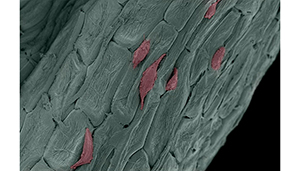 Researchers at the University of Wisconsin-Madison are aiming to create novel biomedical implants using 3D scaffolds made from the decellularized husks of parsley, vanilla and orchids. The team described their work in an article published in Advanced Healthcare Materials.
Researchers at the University of Wisconsin-Madison are aiming to create novel biomedical implants using 3D scaffolds made from the decellularized husks of parsley, vanilla and orchids. The team described their work in an article published in Advanced Healthcare Materials.
“Nature provides us with a tremendous reservoir of structures in plants,” lead author Gianluca Fontana said in prepared remarks. “You can pick the structure you want.”
The team observed that some plants have the strength, rigidity, porosity, low mass and surface area to be structurally efficient as a scaffold.
“Plants are really special materials as they have a very high surface area to volume ratio, and their pore structure is uniquely well-designed for fluid transport,” principal investigator William Murphy added.
The researchers teamed up with the Olbrich Botanical Gardens and identified plant species that could be made into structures for biomedical applications. The group turned to plants such as parsley, orchid, bamboo, elephant ear plants and wasabi.
“The vast diversity in the plant kingdom provides virtually any size and shape of interest,” Murphy said. “It really seemed obvious. Plants are extraordinarily good at cultivating new tissues and organs, and there are thousands of different plant species readily available. They represent a tremendous feedstock of new materials for tissue engineering applications.”
When the team decellularized the plant husks and left behind only cellulose, the primary constituent of plants’ cell walls, they found that human stem cells would attach and grow on the structure. Stem cells that were seeded into the scaffolds aligned themselves along the scaffold’s structure.
“Stem cells are sensitive to topography. It influences how cells grow and how well they grow,” Fontana said.
Murphy added that the plant scaffolds are easy to manipulate and are renewable. The team reported that it plans to conduct preclinical studies in an animal model in the near future.
“Toxicity is unlikely, but there is potential for immune responses if these plant scaffolds are implanted into a mammal,” Murphy said. “Significant immune responses are less likely in our approach because the plant cells are removed from the scaffolds.”

